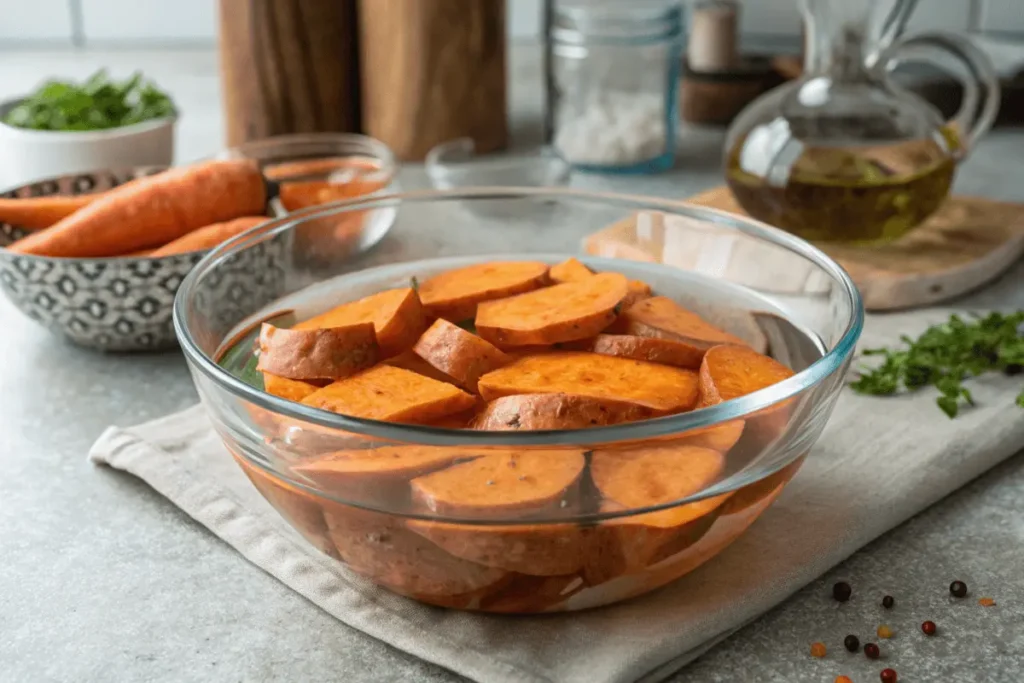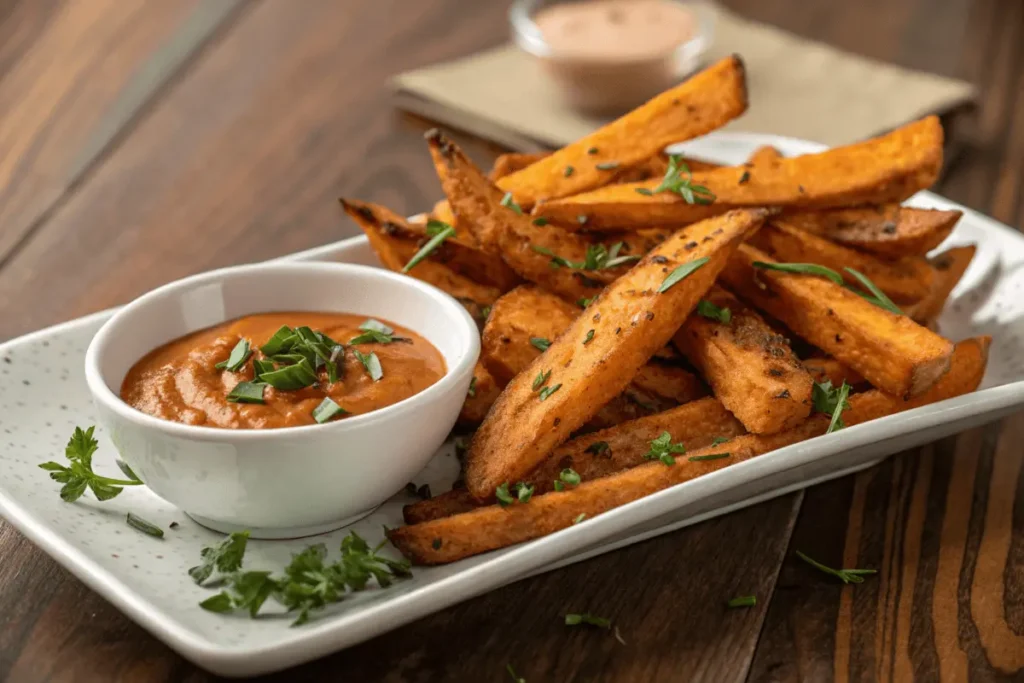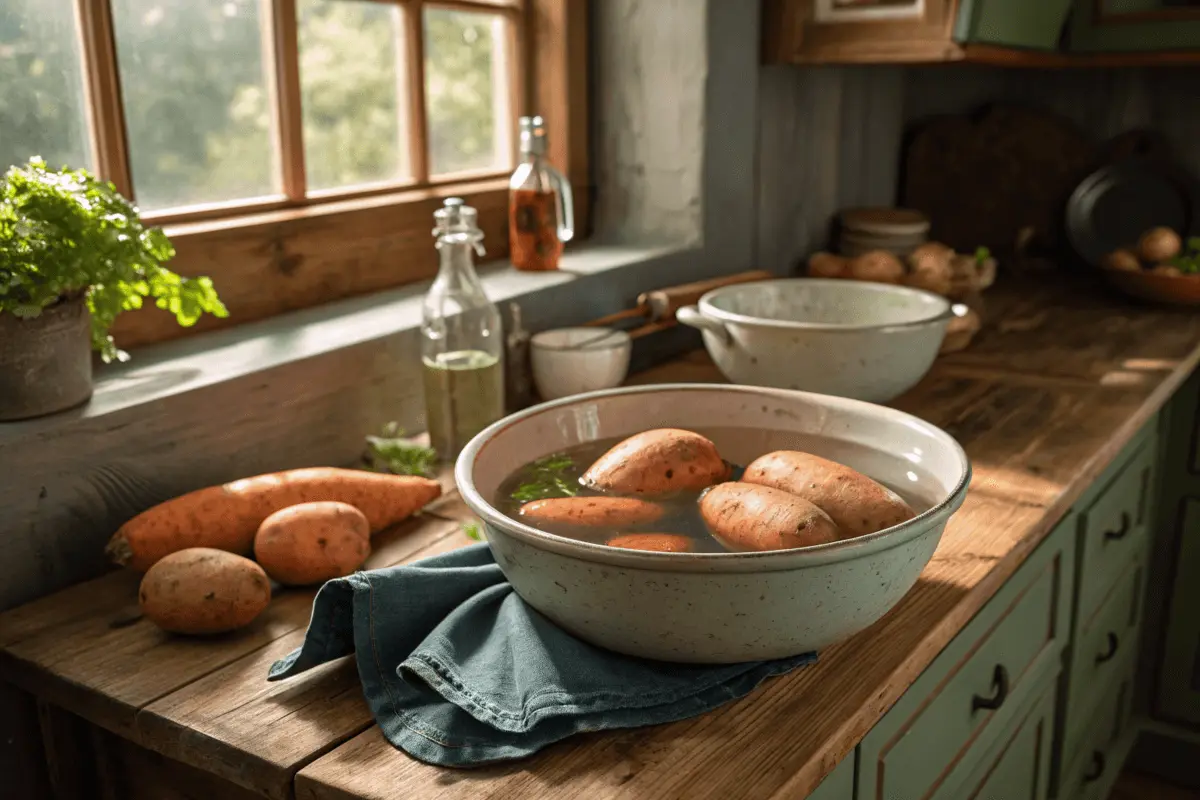Sweet potatoes are a culinary delight known for their sweet taste and versatility. But have you ever wondered, “Why do you soak sweet potatoes before baking?” This practice, seemingly simple, has captured the attention of many cooks and nutritionists alike. From improving texture to enhancing flavor, soaking sweet potatoes can make a world of difference in your dishes.
This article delves into the science, benefits, and techniques behind soaking sweet potatoes. Along the way, we’ll explore common questions, discuss nutritional impacts, and even share recipe ideas to make the most of this humble yet extraordinary root vegetable.
Let’s begin by laying the foundation of what soaking sweet potatoes entails and why it matters.
Introduction to Soaking Sweet Potatoes
What Does Soaking Sweet Potatoes Mean?
Soaking sweet potatoes involves submerging them in water for a specified amount of time before cooking. This step is more than a mere rinse; it’s about allowing water to interact with the starch within the sweet potato. The process is simple but can be transformative for your dishes. The soaking time can vary, but typically, it ranges from 30 minutes to a couple of hours.
Soaking is especially common when preparing certain recipes like roasted wedges or fries. Why? Because the results speak for themselves—crispy on the outside, tender on the inside, and full of flavor. You may also encounter the practice when preparing mashed sweet potatoes or other baked delights.
Why Is This a Popular Practice Among Home Cooks?
For many, soaking sweet potatoes is an easy way to enhance their cooking outcomes. By removing excess starch, you can achieve a lighter texture, prevent dryness, and even promote even cooking. Plus, soaking can improve caramelization during baking, leading to that irresistible golden-brown finish.
Home cooks also find soaking sweet potatoes an excellent pre-cooking step when time allows. It’s a low-effort process that fits easily into your routine, making it ideal for busy kitchens.
The Science Behind Soaking Sweet Potatoes
Starch Removal and Its Effects on Texture
When you soak sweet potatoes before baking, something fascinating happens: water interacts with the starch in the potatoes. Sweet potatoes are naturally starchy, and while starch plays a role in their texture, too much can lead to a dense, gummy consistency when baked. By soaking them, you allow the starch to dissolve into the water, leaving the sweet potatoes lighter and fluffier.
This process also helps in achieving more evenly cooked sweet potatoes. With less starch interfering, the heat penetrates the vegetable uniformly, reducing the risk of overcooking some parts while undercooking others. Whether you’re making sweet potato fries or roasted wedges, soaking ensures a consistent, appealing texture.
Impact on Sweet Potato Flavor and Moisture Retention
Another benefit of soaking sweet potatoes is flavor enhancement. Excess starch can sometimes dull the natural sweetness of the vegetable. By removing it, you allow the sweet, earthy flavors of the potato to shine through. Plus, soaking helps sweet potatoes retain moisture during baking, preventing them from drying out—a common issue when baking them at high temperatures.
Moisture retention is particularly important if you’re aiming for that perfect balance of crispy edges and tender insides. For recipes like fries or wedges, soaking gives you that golden-brown crunch without compromising the soft, delectable core.
By understanding these scientific principles, it’s clear that soaking sweet potatoes before baking isn’t just a culinary trend; it’s a reliable way to elevate the texture and flavor of this beloved root vegetable.

Benefits of Soaking Sweet Potatoes Before Baking
Achieving a Lighter and Fluffier Texture
One of the main reasons why you soak sweet potatoes before baking is to achieve a light, airy texture. Without soaking, the starch in sweet potatoes can lead to a dense interior, especially in thicker cuts. Soaking mitigates this issue by breaking down the starch, allowing the vegetable to bake more evenly and develop that sought-after fluffy interior.
This is particularly evident when preparing mashed sweet potatoes. A lighter texture means smoother, creamier results, making your dish more enjoyable and visually appealing.
Preventing Dryness During Baking
Baking sweet potatoes without soaking can sometimes result in dryness, especially if they’re cut into smaller pieces. Soaking them ensures they absorb some water, which acts as a buffer against the heat of the oven. As a result, the sweet potatoes stay moist and tender even after extended baking times.
This moisture retention is vital for recipes like roasted sweet potato cubes or casseroles, where you want the potatoes to remain juicy yet hold their shape.
Enhanced Cooking Consistency
Soaking also leads to more consistent cooking. By reducing the starch content, sweet potatoes are less likely to develop overly crispy exteriors while remaining undercooked inside. This balance is essential for dishes where texture matters, such as fries or baked sweet potato slices.
For tips on selecting and storing sweet potatoes, check out this guide on sweet potato uses and storage.
Step-by-Step Guide to Soaking Sweet Potatoes
Preparing the Sweet Potatoes for Soaking
Before soaking sweet potatoes, start by cleaning them thoroughly. Use a vegetable brush under running water to scrub away any dirt or debris from the skin. If you prefer peeled sweet potatoes, this is the time to remove the skin using a peeler. However, the skin contains nutrients and adds a rustic touch to many dishes, so leaving it on is an excellent option.
Next, decide whether to soak the sweet potatoes whole, sliced, or cubed. Smaller pieces allow for quicker soaking and are ideal for fries or roasted cubes, while whole potatoes benefit from extended soaking for more even baking.
Recommended Soaking Time and Water Temperature
The optimal soaking time for sweet potatoes is between 30 minutes and 2 hours. This timeframe is sufficient to remove excess starch and improve texture without compromising the integrity of the vegetable. Use cold or room-temperature water for soaking. If you’re short on time, warm water can speed up the process, but it’s important to avoid hot water as it may begin to cook the potatoes prematurely.
Drying Sweet Potatoes After Soaking
Once soaked, gently pat the sweet potatoes dry with a clean towel. They don’t need to be completely dry—slightly damp potatoes can still bake beautifully. Removing excess moisture ensures that they crisp up nicely during baking without becoming soggy.
For another kitchen tip, you might enjoy this article on creative uses of sweet potatoes.
Common Questions About Soaking Sweet Potatoes (FAQ)
Can You Soak Sweet Potatoes Overnight?
No, soaking sweet potatoes overnight isn’t recommended. Extended soaking can cause the potatoes to absorb too much water, leading to a mushy texture that doesn’t bake well. Stick to the suggested timeframe of 30 minutes to 2 hours for the best results.
Should Sweet Potatoes Be Peeled Before Soaking?
Peeling sweet potatoes before soaking is entirely optional. If your recipe calls for peeled potatoes, it’s best to peel them before soaking. However, if you prefer the added nutrients and flavor of the skin, you can soak them with the skin on. Either way, soaking improves their texture and enhances baking outcomes.
What Happens If You Skip the Soaking Step?
Skipping soaking may result in sweet potatoes with a denser texture and uneven baking. Without soaking, the starch content remains high, potentially causing the sweet potatoes to become gummy. While you can bake sweet potatoes without soaking, you might miss out on the lighter, fluffier consistency that soaking provides.
Is Soaking Necessary for All Sweet Potato Recipes?
Not every recipe requires soaking. For instance, when steaming or boiling sweet potatoes, soaking is unnecessary because the cooking process naturally addresses starch content. However, for baked dishes like fries, wedges, or casseroles, soaking ensures optimal results.
For more insights on creative potato dishes, browse through this collection of recipes.
By addressing these common questions, we’ve highlighted why soaking sweet potatoes before baking can elevate your dishes. From crispy fries to perfectly baked whole potatoes, this simple step makes all the difference.
Alternatives to Soaking Sweet Potatoes
Blanching Sweet Potatoes
Blanching is an excellent alternative to soaking sweet potatoes when you’re short on time. This method involves briefly boiling the sweet potatoes, either whole or sliced, for a few minutes before transferring them to an ice bath. Blanching softens the exterior, removes some starch, and helps prepare them for baking. It’s a great choice for recipes requiring crispy edges, like fries or wedges.
To blanch sweet potatoes, bring a pot of water to a boil, drop the sweet potatoes in for 3–5 minutes, and then immediately transfer them to a bowl of ice water. This process halts the cooking and preserves their natural texture, making them ready for seasoning and baking.
Using Other Methods to Achieve Similar Results
If soaking or blanching isn’t an option, there are still ways to improve the texture and flavor of baked sweet potatoes. For example, tossing them with a light coating of cornstarch before baking can mimic the effect of reduced starch content. This technique works wonders for achieving a crispy exterior.
Another option is to roast sweet potatoes at a higher temperature, around 425°F (220°C). The intense heat helps create caramelization and crispy edges without soaking. While these methods won’t fully replicate the benefits of soaking, they can still produce delicious results.
Each alternative offers unique advantages, but it’s clear why soaking sweet potatoes before baking remains a popular and reliable method for improving texture and flavor.
Nutritional Impact of Soaking Sweet Potatoes
Does Soaking Reduce Nutrients in Sweet Potatoes?
A common concern about soaking sweet potatoes is whether it reduces their nutritional value. The good news is that soaking has minimal impact on their nutrients. Sweet potatoes are packed with vitamins, minerals, and antioxidants, most of which are not water-soluble. This means their nutrient content remains largely intact, even after soaking.
However, prolonged soaking, especially overnight, may lead to a slight loss of water-soluble nutrients like vitamin C. That’s another reason why it’s best to limit the soaking time to a maximum of two hours.
Retaining Nutritional Value After Baking
Soaking sweet potatoes not only enhances their texture but also prepares them for more effective nutrient retention during baking. Baking is one of the healthiest cooking methods for sweet potatoes, as it preserves their fiber, beta-carotene, and other beneficial compounds.
If you’re looking to boost the nutritional profile of your sweet potato dishes, consider leaving the skin on. The skin contains extra fiber and antioxidants, making your meal even healthier.
By soaking sweet potatoes for the recommended duration, you can enjoy their improved texture and flavor without worrying about significant nutrient loss. This step ensures you’re getting the most out of this naturally nutritious and versatile vegetable.
Recipes Enhanced by Soaking Sweet Potatoes
Sweet Potato Fries
If you’ve ever wondered, “Why do you soak sweet potatoes before baking?” fries provide a clear answer. Soaking sliced sweet potatoes before baking removes excess starch, resulting in crispier, golden-brown fries. After soaking for 30 minutes to an hour, pat them dry, toss them with olive oil, and season with salt, pepper, and your favorite spices. Bake them at 425°F (220°C) for 20–30 minutes, flipping halfway through. The result? Perfectly crisp on the outside, tender on the inside fries that rival any deep-fried version.
Roasted Sweet Potato Wedges
Roasted sweet potato wedges are another dish that benefits greatly from soaking. By soaking the wedges, you allow the natural sugars to caramelize beautifully during baking. After soaking, toss them with a blend of olive oil, paprika, and garlic powder. Roast at 400°F (200°C) until they’re slightly crispy on the edges and soft in the center. This method ensures each bite is full of flavor and texture.
Mashed Sweet Potatoes
For the creamiest mashed sweet potatoes, soaking whole sweet potatoes before boiling or baking can make a noticeable difference. It softens their structure, making them easier to mash. Blend the cooked potatoes with butter, cream, and a touch of cinnamon for a dish that’s smooth, flavorful, and indulgent.

For more ideas on using sweet potatoes in creative recipes, explore this recipe guide on sweet potato dishes.
Conclusion and Final Thoughts
Summary of the Advantages of Soaking
Soaking sweet potatoes before baking is a straightforward step that enhances your culinary results. But why do you soak sweet potatoes before baking? The answer lies in the benefits of removing excess starch, which leads to lighter and fluffier dishes. Soaking also prevents dryness, ensuring your sweet potatoes retain moisture and bake to perfection. Whether you’re crafting crispy fries, caramelized wedges, or creamy mashed potatoes, soaking sets the foundation for success.
Tips for Incorporating Soaking Into Your Routine
Incorporating soaking into your routine is easy and incredibly beneficial. To answer the question why do you soak sweet potatoes before baking, consider that it only takes 30 minutes to two hours to make a noticeable difference in texture and flavor. Remember to pat the sweet potatoes dry after soaking to achieve the desired crispiness or creaminess in your dish. You can also decide whether to peel them or leave the nutrient-rich skin on, depending on the recipe.
So, why do you soak sweet potatoes before baking? It’s all about making the most of their natural qualities. This step helps you create dishes that are not only visually appealing but also bursting with flavor and perfect texture. Give it a try, and your next meal will be a testament to the power of this simple kitchen technique.


1 thought on “Why do you soak sweet potatoes before baking?”